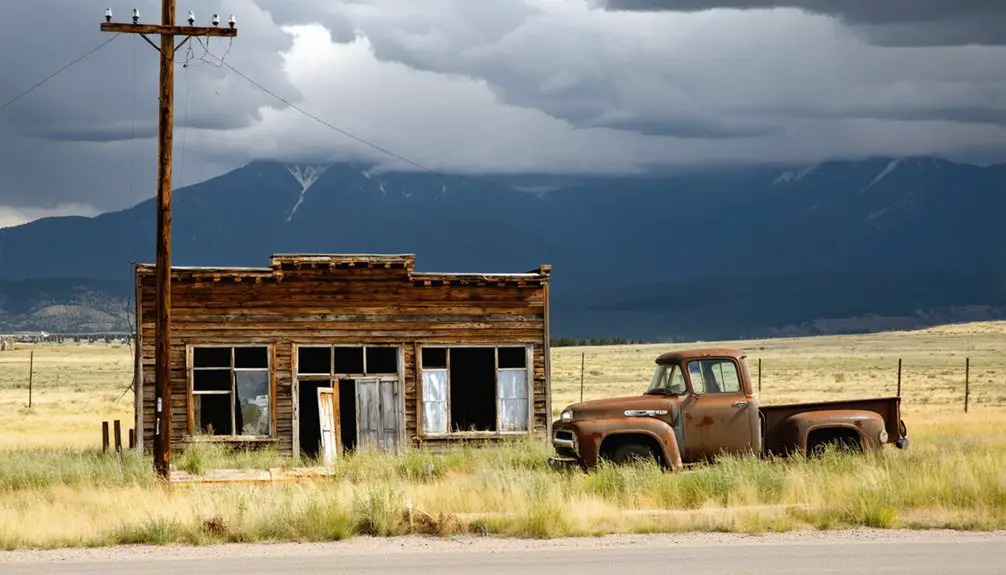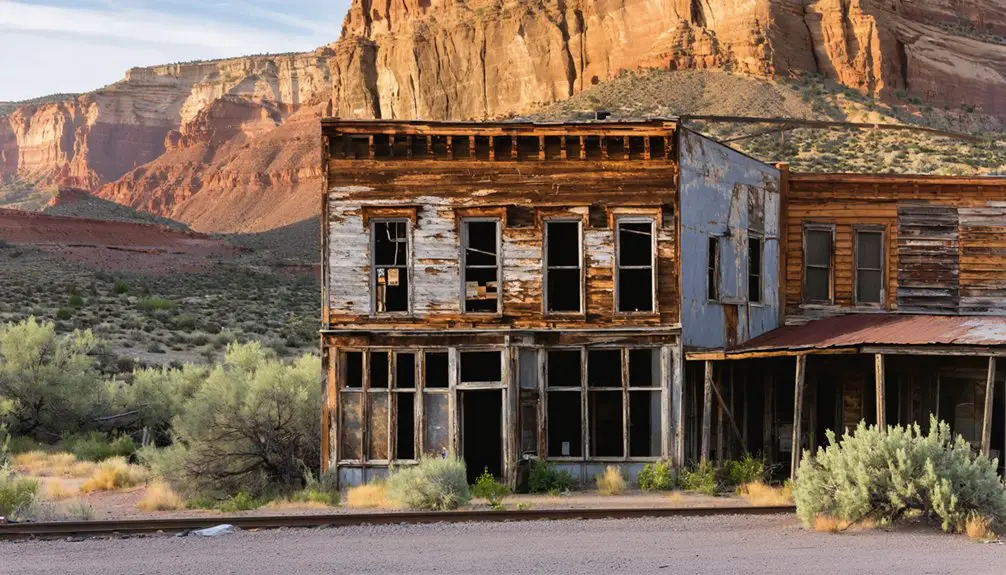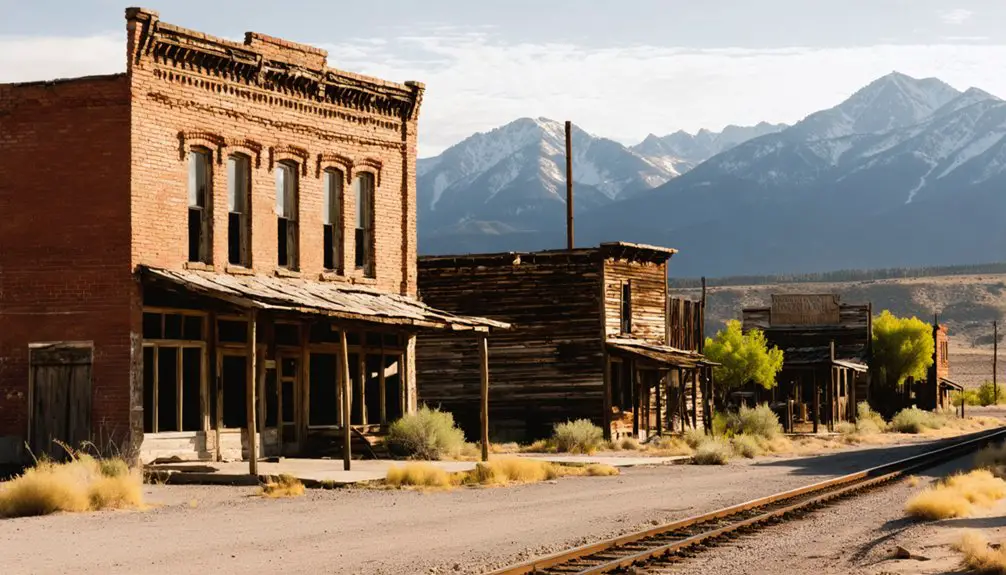You’ll find Thistle, Utah’s haunting remains in Spanish Fork Canyon, where a once-bustling railroad hub met its tragic end. The town flourished in the late 1800s as a critical stop on the Denver & Rio Grande Western Railroad, supporting 600 residents by 1917. A devastating landslide in 1983 submerged the town under 50 feet of water, causing $200 million in damages. Today, partially sunken buildings and scattered ruins tell the remarkable story of this modern American ghost town.
Key Takeaways
- Thistle was a thriving railroad town in Utah that became a ghost town after a devastating landslide and flood in 1983.
- The landslide destroyed the entire town, submerging it under 50 feet of water and causing $200 million in damages.
- Prior to destruction, Thistle served as a crucial railroad hub with extensive infrastructure, supporting 600 workers by 1917.
- Today, only scattered ruins remain visible, including a partially submerged house and deteriorating train machine shop.
- A 2018 wildfire destroyed most remaining structures, leaving the area as a haunting reminder of nature’s destructive power.
The Birth of a Railroad Boomtown
As the Denver and Rio Grande Western Railroad expanded westward in the late 1800s, the small settlement of Thistle emerged as an essential railroad hub in Utah’s Spanish Fork Canyon.
You’ll find the town’s origins traced to 1878, when the Utah and Pleasant Valley Railway first laid a narrow-gauge line to service local coal mines. The D&RGW’s acquisition and conversion to standard gauge by 1890 launched Thistle’s transformation into a bustling railroad center.
The railroad expansion triggered dramatic economic growth, as Thistle developed extensive infrastructure including a five-stall roundhouse, engine turntable, and machine shops. The convergence of two major highways and rail lines made Thistle a crucial transportation junction. By 1917, Thistle had grown into a thriving community with over 1,600 residents.
Life in Early Thistle Settlement
While the railroad powered Thistle’s growth, the town’s social fabric emerged from its earliest settlers in 1848.
Mormon pioneers, including the Pace family, established early agriculture in what they called “Little Paradise Valley,” laying the foundation for a thriving community. The town reached its zenith when 600 residents lived in Thistle by 1917. The eventual diesel engine transition in the 1950s marked the beginning of the town’s decline.
These early settler experiences shaped Thistle’s development through:
- Creation of the U-Pace-O Ranch, marking the beginning of local ranching operations
- Formation of communal gathering spaces, from makeshift meeting areas to the eventual two-story schoolhouse
- Establishment of essential businesses like general stores and bakeries that served both residents and railroad workers
Railroad Glory Days
During the 1890s, Thistle transformed into a critical railroad hub when the Denver & Rio Grande Western Railroad completed its branch line through Sanpete Valley.
You would’ve witnessed remarkable railroad expansion as the Utah Railway built a parallel line in 1912, leading to joint trackage agreements that streamlined operations between Thistle and Provo. The company’s initial six locomotives were 2-10-2 models designed by Union Pacific.
The economic transformation was profound. By 1917, Thistle’s population swelled to 600 residents as railroad employment surged.
The bustling railroad town of Thistle reached its peak in 1917, with 600 residents employed in the booming rail industry.
The town buzzed with activity around its extensive facilities – a roundhouse, turntable, depot, and helper engines that assisted trains up the steep grade to Soldier Summit. Farmers and ranchers relied on the town’s essential weed classification guidelines to protect their grazing lands from invasive thistle species.
You’d have seen freight trains carrying minerals, manufacturing goods, and agricultural products from eastern Utah mines, while the Marysvale Branch opened additional routes to mining regions.
The railroads’ cooperation made Thistle a crucial link on the Salt Lake City-Denver route.
Community and Daily Life
Once Mormon pioneers established Thistle in 1878, the town quickly evolved into a vibrant community where railroad workers and ranching families built their lives together.
Daily routines revolved around the railroad’s rhythm, with residents coordinating their schedules to the steady flow of steam locomotives requiring service and supplies. At its height, the town supported a thriving population of 650 residents. The town remained prosperous until the devastating mudslide of 1983 destroyed nearly everything.
Community gatherings flourished in the town’s various establishments:
- The two-story schoolhouse served as an educational hub for local children.
- Restaurants, saloons, and pool halls provided social spaces for workers to unwind.
- The general store and post office created natural meeting points for residents.
Life centered around homesteads and ranch houses within walking distance of the railroad facilities, where telegraphers managed essential communications.
This close-knit arrangement fostered strong bonds among families who called the Spanish Fork Valley home.
The Fateful Spring of 1983
As unprecedented snowfall and rainfall saturated Utah’s Wasatch Front in early 1983, Thistle stood on the brink of catastrophe.
The spring rains intensified ground instability that railroad crews had noticed for years but hadn’t fully investigated. By April 13, you would’ve seen the first major landslide warnings as railroad tracks shifted several inches and a highway patrol officer encountered a buckled US-6.
Early warning signs emerged when crews spotted shifting tracks and buckling roads – clear signals of the impending disaster.
The situation deteriorated rapidly between April 13-16. After initial warnings, officials ordered complete evacuation orders for all Thistle residents. The flooding transformed homes into floating debris as rooftops detached and drifted across the rising waters.
You’d have witnessed surface deformation accelerate as an ancient paleovalley depression reactivated, pushing earth and debris across transportation corridors. Despite emergency efforts to maintain river flow, the slide dammed the Spanish Fork River.
Nature’s Devastating Force
While Utah had experienced natural disasters before, the Thistle landslide of 1983 demonstrated nature’s raw power on an unprecedented scale. The combination of heavy rains and rapid snowmelt saturated the mountain slopes, creating unstoppable geological hazards that would forever change the landscape.
Here’s how the disaster unfolded:
- Ground saturation weakened the terrain, causing railroad tracks to shift and highways to buckle by April 13.
- The massive earthflow completely dammed the Spanish Fork River, creating a three-mile-long lake.
- Within days, the rising waters submerged the town under 50 feet of water, leaving only rooftops visible.
You’ll find it hard to imagine the raw force that buried highways and railroads under 50 feet of soil, creating America’s costliest landslide at over $200 million in damages.
Aftermath and Abandonment

Before the devastating 1983 landslide, Thistle had already experienced significant decline, with only 22 occupied homes and a dwindling population.
The disaster’s impact sealed the town’s fate, as floodwaters swept away buildings, vehicles, and critical infrastructure, leaving only scattered foundations behind.
The lack of disaster preparedness became evident as residents rushed to evacuate with whatever belongings they could salvage.
Flood recovery efforts proved futile, and most homeowners accepted state buyouts, permanently abandoning their properties.
The site was officially designated a disaster zone, restricting future development.
You’ll find that Thistle’s transformation into a ghost town was complete when the remaining structures succumbed to nature’s forces.
A 2018 wildfire destroyed what little was left, leaving behind only memories of this once-thriving railroad community.
What Remains Today
Today, visitors to Thistle encounter a haunting landscape where water and wilderness have reclaimed most of the former railroad town. The ghostly atmosphere reveals submerged ruins beneath murky waters, with a partially sunken house serving as the most striking reminder of the 1983 disaster.
Beneath murky waters, Thistle’s ghostly remains tell the story of a once-thriving railroad town lost to disaster.
When you explore the roadside viewpoints, you’ll find:
- A red schoolhouse and deteriorating train machine shop still visible from the road
- Foundations of several homes, though many were damaged by the 2018 wildfire
- Floating debris and rooftops scattered across the swampy terrain
While the railroad infrastructure that once defined Thistle lies mostly underwater, you can still glimpse traces of its past through the remaining structures.
Fencing protects key historical sites, though no formal visitor center exists to preserve the town’s memory.
Legacy of a Lost Town

Although Thistle’s physical structures now lie mostly underwater, the town’s legacy endures as a powerful symbol of both human resilience and nature’s force.
You’ll find its cultural heritage preserved through local histories, ghost town literature, and the vivid memories of displaced residents and former railroad workers.
The 1983 disaster marked a dramatic turning point in Utah’s environmental impact awareness, becoming the costliest landslide in U.S. history.
You can still witness the town’s remnants through half-submerged buildings and deteriorating foundations visible from nearby highways.
While access remains restricted due to safety concerns, Thistle’s story continues to draw curious visitors and historians.
The town’s transformation from a thriving railroad hub to a submerged ghost town serves as a sobering reminder of how quickly communities can change when nature intervenes.
Historical Significance and Impact
Established in 1878 amid the rugged Spanish Fork Valley, Thistle rapidly evolved from a humble Mormon pioneer settlement into an essential railroad hub that shaped Utah’s transportation landscape.
The town’s cultural impact resonates through the American West’s development, teaching valuable lessons about human resilience and nature’s power.
Three key aspects define Thistle’s historical significance:
- It served as a critical junction for the Denver and Rio Grande Western Railroad, connecting mining and agricultural economies.
- The 1983 landslide became a watershed moment in geological studies, influencing modern engineering practices.
- The town’s transformation from thriving community to submerged ghost town exemplifies the delicate balance between human settlement and environmental forces.
You’ll find Thistle’s legacy endures as a sobering reminder of nature’s might and the impermanence of human achievements.
Frequently Asked Questions
Are There Any Ghost Stories or Paranormal Activities Reported in Thistle?
You’ll find few documented ghost sightings, though local legends tell of eerie feelings near the submerged ruins. Most paranormal claims stem from visitor impressions of the tragic landscape’s haunting atmosphere.
What Happened to the Cemetery and Burial Sites After the Flood?
You’ll find no cemetery preservation efforts documented – the flood impact left burial sites permanently submerged under water and sediment, with graves remaining buried beneath the lake formed by the landslide.
How Deep Is the Water That Currently Covers the Town?
While water depth varies seasonally, you’ll find about 50-160 feet of water covering the town today. Don’t let outdated reports fool you – engineering projects have helped stabilize these levels since the 1983 disaster.
Did Any Original Residents Return to Live Near Thistle After 1983?
While original residents relocated to nearby towns like Spanish Fork and Birdseye after 1983, you won’t find evidence of anyone returning to live near Thistle’s submerged ruins due to safety concerns.
Can Visitors Take Artifacts or Souvenirs From the Ghost Town Site?
No, you can’t take artifacts – it’s illegal and violates ghost town ethics. While the freedom to explore is yours, artifact preservation guarantees future generations can study and appreciate this historic site.
References
- https://diaryofabandonment.com/thistle-ghost-town-utah/
- https://www.uen.org/utah_history_encyclopedia/t/THISTLE.shtml
- https://saltproject.co/blog/thistle-ghost-town
- https://en.wikipedia.org/wiki/Thistle
- https://architecturalafterlife.com/2019/01/a-century-old-ghost-town-wiped-out-by-a-massive-landslide/
- https://thedeadhistory.com/2016/05/14/thistle-utah-landslide-disaster/
- https://www.youtube.com/watch?v=eWoddf0d0fk
- https://landingaday.wordpress.com/2023/03/17/thistle-utah-revisited/
- https://digging-history.com/2014/05/14/ghost-town-wednesday-thistle-utah/
- https://utahrails.net/utah-ry/utah-ry-history.php



